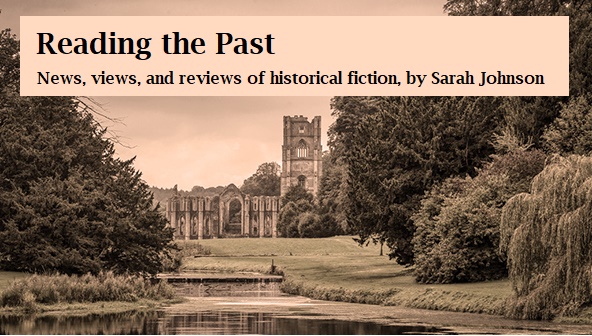I'm pleased to have actor, singer, and historical novelist Christina Britton Conroy joining me today at Reading the Past for a fascinating post about the lives of actors in Victorian times and after. She has a new four-book series, set in the theatrical world of Victorian and Edwardian England, just out from Endeavour Press.
~
Writing Novels about Victorian Theatre
Christina Britton Conroy
Having spent my early life as a professional singer/actor, it is no wonder I chose the Victorian theatre to set my 4-book series
His Majesty's Theatre. Pouring through real and fictional theatrical accounts, I am especially fond of Charles Dickens'
Nicholas Nickleby and Clarence Dane's
Broom Stages (rereleased as
Theatre Royal). Extensive study in London libraries completed my research. Actors who were not yet, or never would become, stars usually struggled to afford a dry roof and enough food to keep from starving. Theatrical boarding houses were few and far between, for good reason. If tickets didn't sell, and/or a shady producer took off before paying his actors, midnight flits out back windows were commonplace. Even legitimate producers were allowed to withhold salaries if a performance was cancelled because of natural causes.
At least jobs for actors were plentiful. Experience was seldom a prerequisite for hiring. Actor-manager Herbert Beerbohm Tree was the first to teach acting technique. In 1904, his classed evolved into the Royal Academy of Dramatic Art. Most actors learned on-the-job. Tree built Her Majesty's Theatre in 1887. When Edward VII was crowned in 1901, the theatre name was changed to His Majesty's.
Most actors were expected to learn their roles from sides (sheets with only their own lines on the page). They provided their own costumes, wigs, and makeup. There are accounts of dancing girls spending most of their hard-earned wages replacing torn stockings.
In small road companies, the actors were also the backstage crew, setting up their stage, rigging, lights, making and mending costumes, and roaming each new town, passing out tear sheets and selling tickets. A newly hired actor could be expected to learn several long roles almost instantly, rehearse night and day, and still have enough energy to project his/her voice over a rowdy audience. If a small company played a town for 8 days, they need to perform 8 different plays. Old actors could seldom stand these rigors, so young actors drew overlarge wrinkles onto smooth brows, powered dark hair to make it gray, walked bent over, and tried to look old.
The few star actors and actor-managers like Henry Irving, and Herman Beerbohm Tree made vast salaries, built their own theatres, and treated their actors fairly. They also took their companies on tours of the world.
Many well paid "tragic actors" took time from the legitimate theatre to play Pantomimes. These elaborately silly holiday children's shows rehearsed for 3-4 weeks, opened on Boxing Day (December 26th) and played for several weeks. Rehearsals were not paid, but actors could still earn more in a short Pantomime season than an entire year playing small roles for Henry Irving.
Learning all this quaint information made me shake my head. Being an actor is 2018 is very similar. The major difference is that now, there is less work for actors.
I was lucky to get a union card at the age of 7. Actors Equity Association demands producers pay a bond before a show goes into production. This ensures that actors will be paid and brought home, even if a show closes out of town. Rehearsal and performance hours are still long, but reasonable. Even working in summer stock, when one show is playing 8-9 performances a week, and two more shows are rehearsing during offstage hours, the actors and crew are guaranteed 11 hours off after an evening curtain falls and rehearsal can begin the next day. Contracts vary according to the budget of the theatre, but breaks for meals, warm dressing rooms in winter, and other basic necessities are guaranteed.

Non-union theatres still do whatever they want. The only nonunion gig I played was Jenny Lind in
Barnum on a cruise ship. There were no unions on the high seas. The play alternated nights with a Las Vegas-type revue called
Sea Legs. I was horrified when a new
Sea Legs number was put into that show and the dancers were rehearsed all night, after the
Barnum curtain came down. They were allowed a couple hours sleep before the next
Barnum matinee. Since that is a circus show, with some dancers swinging on ropes over the audience, it was amazing no one got hurt.
In 2018, every theatre performer wants to be on Broadway. The work is hard, but salaries and perks are high. Walking through Times Square, pedestrians are accosted by attractive young people costumed from a current show, handing out fliers. These actors are never in Broadway shows, but may be in Off Broadway shows playing just around the corner.
Much like 19th-century Pantomime stars, modern TV/film stars performing on Broadway take huge cuts in their usual salaries. One female star told an interviewer she was paying her nanny more that she was taking home in her pay envelope.
The summer stock season of 1988, I was cast in
The Women. The show is about the scandal of divorce in the 1930s. Since regional theatre producers can ask actors to provide their own clothes for contemporary plays, they decided to set the play in 1988. When the director arrived, reminded them there was no scandal of divorce in 1988 and the play would be nonsense, most contemporary clothes brought by the actors didn't work. Anticipating the problem, I brought clothes that worked for both periods. The rest of the cast scrambled, sent home for other clothes and went shopping.
We were always paid on a Friday, and the last show of the week was on Sunday. Before the very last Sunday show, we had not been paid. One of our stars, Julie Newmar (best remembered as Cat Woman), refused to go on until we were all paid. Thanks to Julie and the Equity bond, we were paid and flown home to New York.
Reference: Jackson, Russell,
Victorian Theatre (A & C Black, London, 1989).
Christina Britton Conroy, M.A., C.M.T., L.C.A.T.
www.ChristinaBrittonConroy.com
~
Novelist / screenwriter / singer / actor / Irish harpist / Certified Music Therapist / Licensed Creative Arts Therapist
Christina Britton Conroy has many passions.
A classically trained singer/actor, Christina toured the globe singing operas, operettas, and musicals. She soloed with orchestras, oratorio societies, at Radio City Music Hall, and folk venues, accompanying herself on the guitar and Irish Harp. Her theatrical credits include:
On the Twentieth Century, directed by Harold Prince, with Rock Hudson, Imogene Coca, and Judy Kaye;
The Women with Anita Gillette, Dody Goodman, Julie Newmar, Virginia Graham, Jane Kean, and Margaux Hemingway; and the original Actors Studio production of
Let ‘em Rot by Cy Coleman, directed by Morton DaCosta.
As a Certified Music Therapist and Licensed Creative Arts Therapist, Christina has enriched the lives of children, adults, their families, and caregivers. She is also the Founder and Executive Director of
Music Gives Life, bring musical performing into the lives of senior citizens. NY1 - TV NEWS named her NYer Of The Week.
Christina's education includes creative writing and screenwriting at NYU; acting at The Actors' Studio and NY School of Film and Television; Music at Juilliard Pre-College, Interlochen, a music bachelors from U. of Toronto, and music therapy MA from NYU.
OnlineBookClub reviewers wrote: "If you love to read about Downton Abbey era England as much as I do, you are in for a real treat with Christina Britton Conroy’s,
Not From The Stars, Book 1 of His Majesty’s Theatre series. This story has all the requirements of a Shakespearian play; star-crossed lovers, controlling fathers, and cruel betrothal arrangements…" (Endeavour Press, UK 11/2017). The original novel, now a 4-book series, was a Fountainhead Writing Contest finalist.
Christina lives in Greenwich Village, NYC with her husband, actor/media-coach, Larry Conroy.
For more information on her historical novel series, His Majesty’s Theatre:
NOT FROM THE STARS,
http://www.amazon.com/dp/B074VCVWSF
BUT FROM THINE EYES,
http://www.amazon.com/dp/B075NHD6L5
TRUTH AND BEAUTY,
http://www.amazon.com/dp/B076M1MX7D
BEAUTY’S DOOM,
http://www.amazon.com/dp/B0783HLFXV
























